Extra Large Tram: NGT12-LEI in focus
Afternoon all!
Following up to my earlier portrait of our NGT6 "Leoliner" trams by HeiterBlick, I would like to continue this series of showcases with a few paragraphs about our NGT12 trams, which at present are the largest steeds in our stable, if you will.
To provide up-to-date and accessible rolling stock on those lines characterised by particularly high ridership numbers and earmarked for gradual upgrade to light rail equivalent standard with large proportions of grade-separated track, LVB contracted Bombardier in 2003 to develop a five-segment articulated tram based on the Flexity Classic design, taking advantage of the near-parallel development of the NGTD12DD trams for Dresden's DVB. The NGT12-LEI was procured in three batches, two of twelve and one of nine, in 2003, 2005 and 2011 respectively.
These cars are used for all regular turns on Lines 11 and 16 and the majority of those on Line 15, with a few turns on Lines 3 and 7 also being booked with them at this time. Lines 11, 15 and 16 are, in fact, those upgraded to quasi-light rail standard for all or at least much of their length. Due to their high passenger capacity, NGT12 trams can also be seen on Line 4 during football matches or other events taking place in the Leipzig Stadium, now officially called Red Bull Arena.

1228 "Essen" standing by at Angerbrücke for one of the last sorties – onto Line 16, or, more precisely, Turn 1622 – on the morning of 16 October. This is one of the 3rd batch cars, easily recognised by the coloured LED destination signs which but are not currently planned to be refitted to 1st and 2nd batch cars.
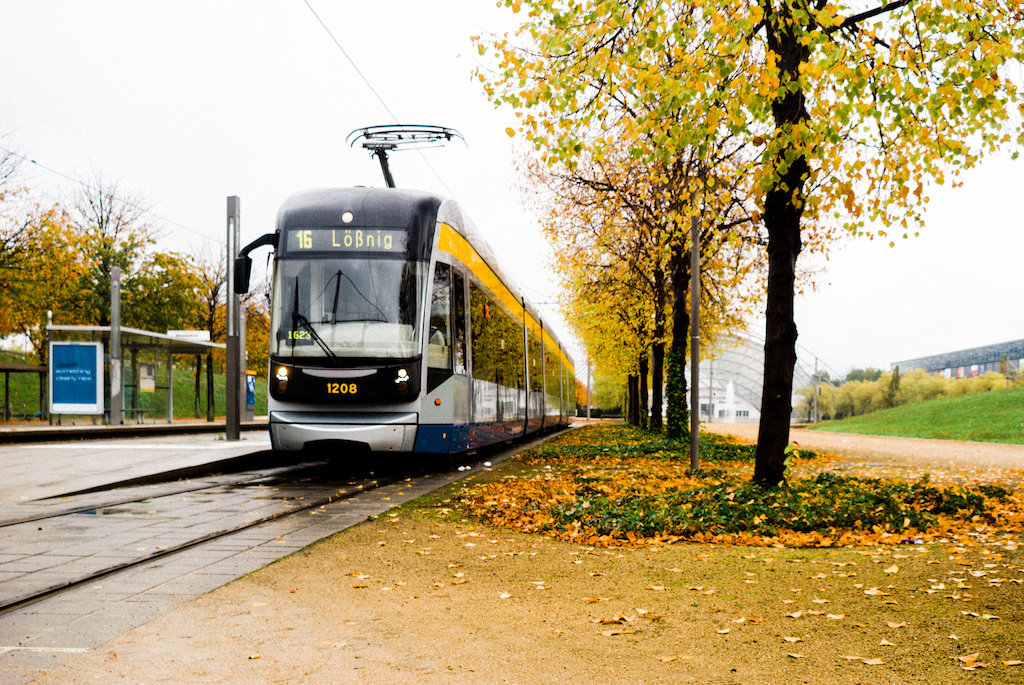
Leaves were falling as 1208 "Nürnberg" was stood at the Exhibition Centre on the north end of Line 16.

On the holding track on Rathausplatz in Schkeuditz, 1208 demonstrates one recent minor upgrade: The monochromatic destination signs on the 1st and 2nd batch cars have been updated to display slightly bolder text, improving readability over the original configuration.

…and later during turnaround on Schillerplatz at Markkleeberg Ost on the south end of Line 11.
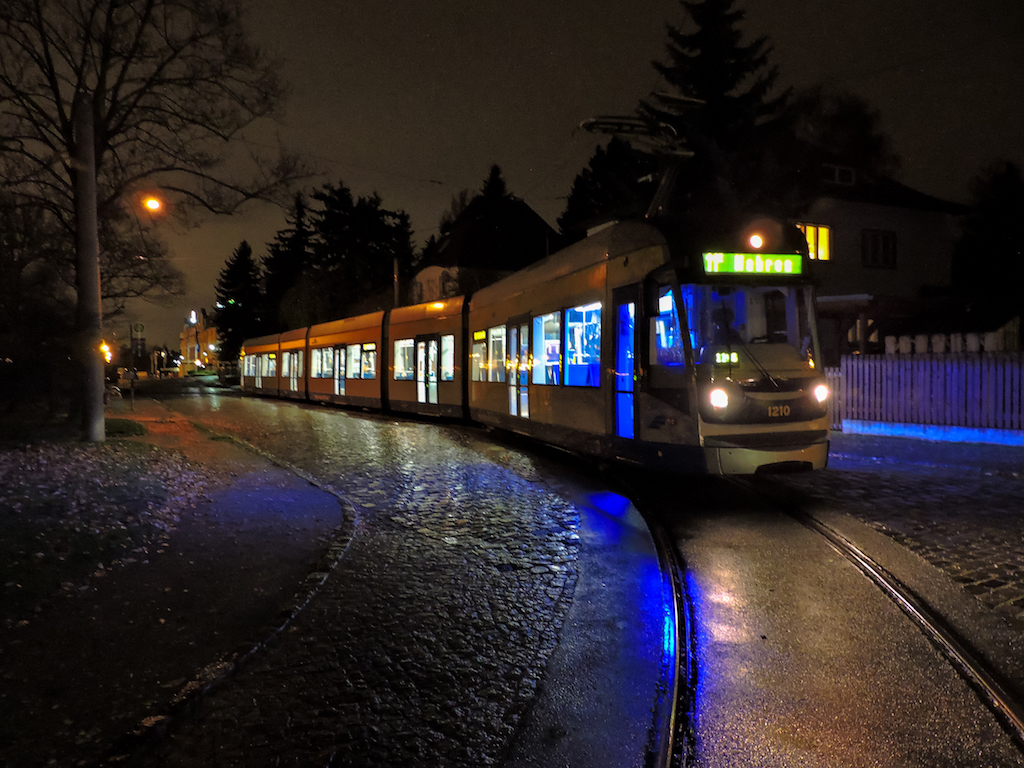
Same location, same day, different time: 1210 "Dortmund" shines its lights through the autumnal night while I was waiting to drive up to the Wahren terminus in Leipzig on Pater Aurelius Square…

…where I arrived while a new band of rain showers passed over the city.

A view from the cab, which in spite of the darkness outside will hopefully suffice to give an impression of a driver's perspective from these cars.

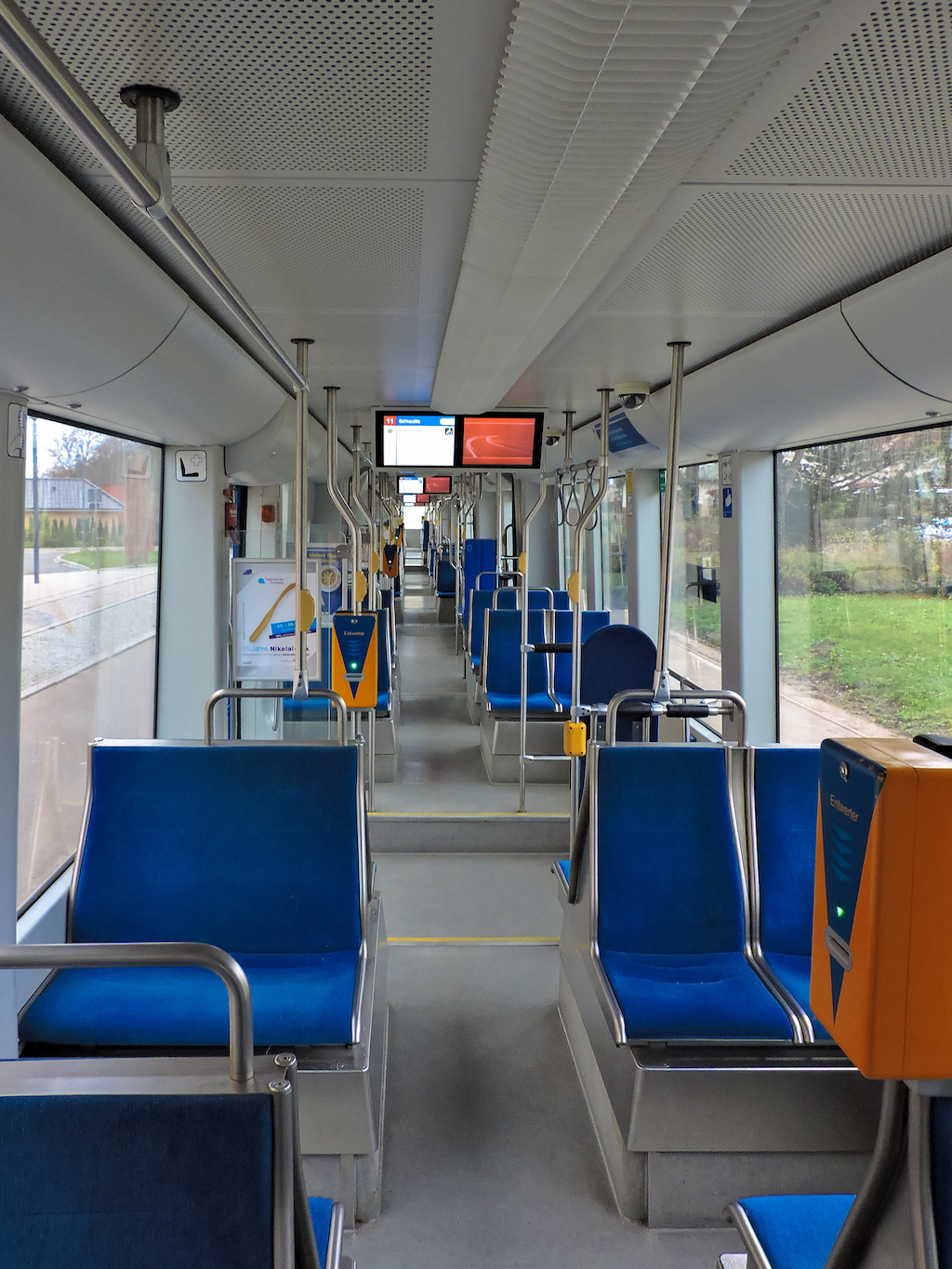
A look through the passenger space…

…and one of the two onboard ticket machines.
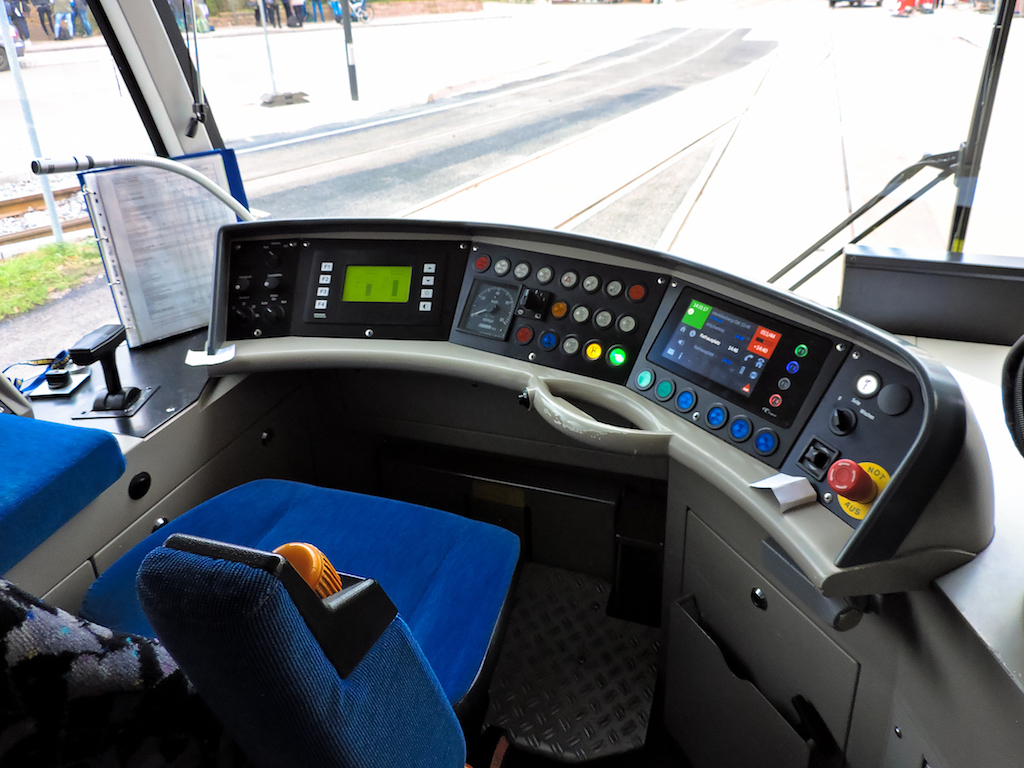
The control panel is, I think, well designed and puts all main functions within easy reach. Once again, note the static balancing handle set for the right hand, which as on the NGT6 has trigger buttons on the inner face for easy manipulation. The button facing the seat is one of two bell triggers, while the buttons set inside the handle are the secondary deadman switch; track brake; and sander.
Note the power/brake controller lever being installed at a slight angle to the front left and having a T-shaped handle which must be rotated 90 degrees clockwise, thus serving as the primary deadman switch. One useful detail is that the controller handle includes a bell trigger, set for the left thumb. Also visible are the reverser knob and activation key lock to the left and in front of the controller.

Additional instruments – mainly for auxiliary systems like the cab air conditioning but also for car preparation and emergency holding brake release – are provided on the secondary panel, located left of the driver's position. Once again, note three lidded activation triggers for holding brake emergency release activation ("Hilfslösen"); breakdown running mode ("Räumfahrt") for removing a severely malfunctioning car from the route; and OHLE de-icing ("Eisfahrt"). The latter function mainly does two things: For one, it enables the traction packages to remain working with an OHLE voltage as low as 400 V rather than the normal lower limit of 520 V, and it also configures the braking rheostats to continuously draw power in order to yield a thermal heating effect on the OHLE wire to assist in removing thick ice. In de-icing mode, speed is automatically limited to 20 kph in order to prevent pantograph bouncing and possible arcing.
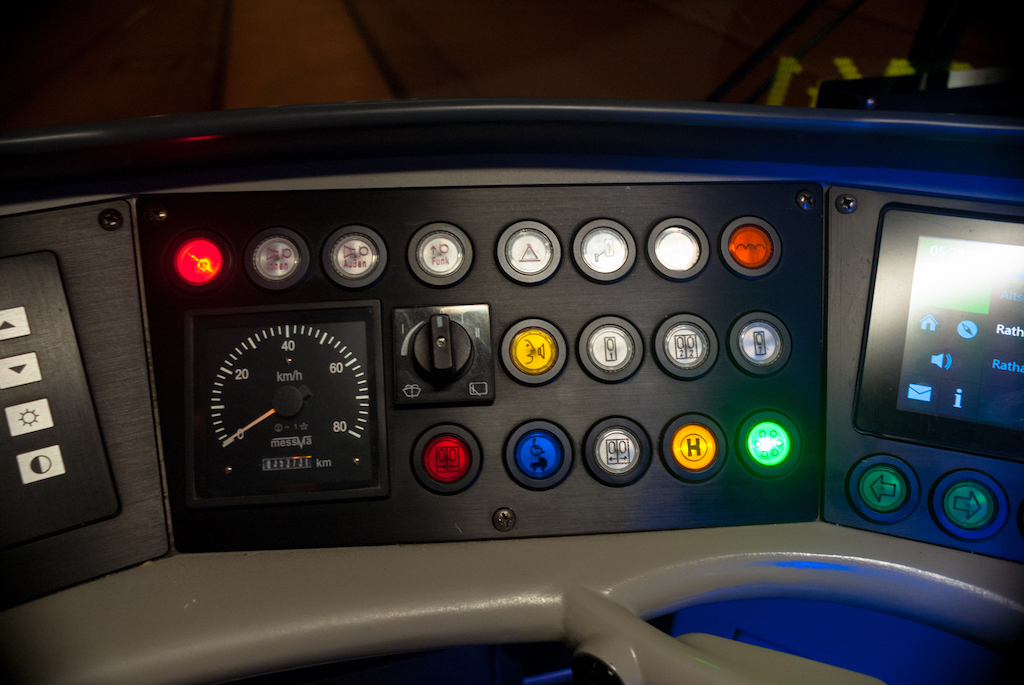
Close-up of the main instrument cluster. Note that on the NGT12, it is possible to manually open Doors 1, 2 and 7 separately.

The diagnostic terminal can be set to display OHLE and battery voltage, which I prefer to do as I like to keep an eye on how much power the car is drawing at any time, which you can, to a degree, extrapolate from variations in the OHLE voltage.
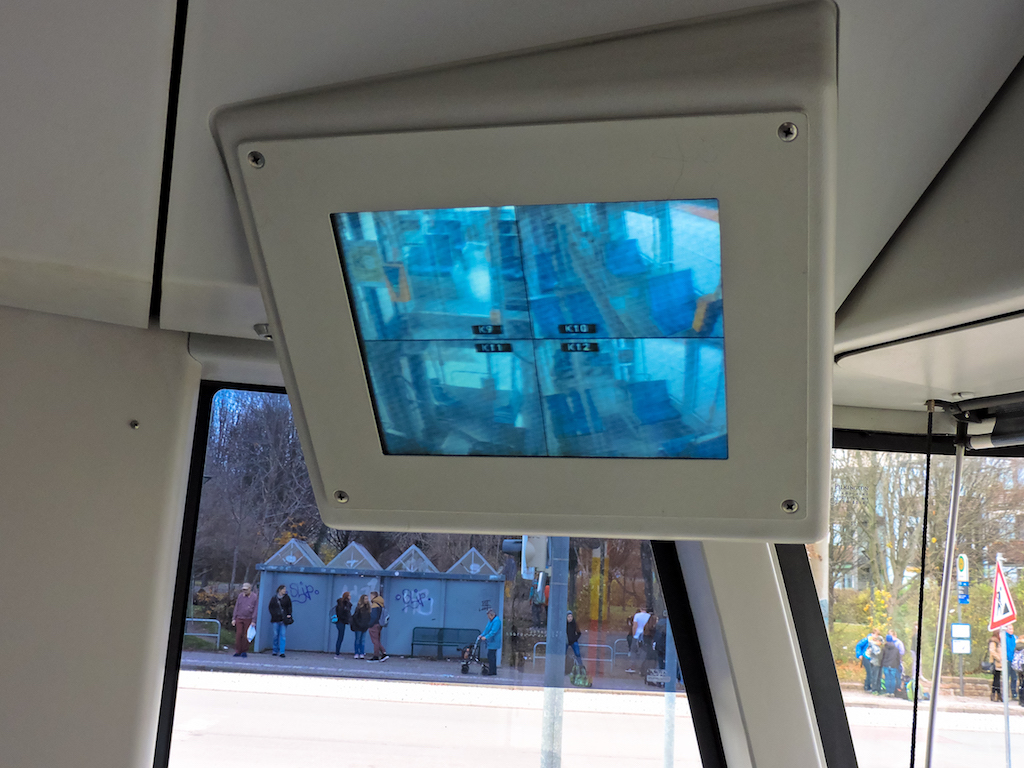
The CCTV monitor is installed to the top left of the driver's position. As on our other types, you can either select a full sized image from any single camera, or quad-split images from groups of four cameras.

It's common for the last revision date and nominal service weight to be written on inside the cabs.

A look at the rear view mirror…

…and the auxiliary control panel at the rear end, hidden under a locked lid.

Tram jam during the recent Blue Lines diversion through the East Circuit while engineering work was carried out on Goethestraße. Again, it's evident that visibility from the NGT12 cab is excellent.
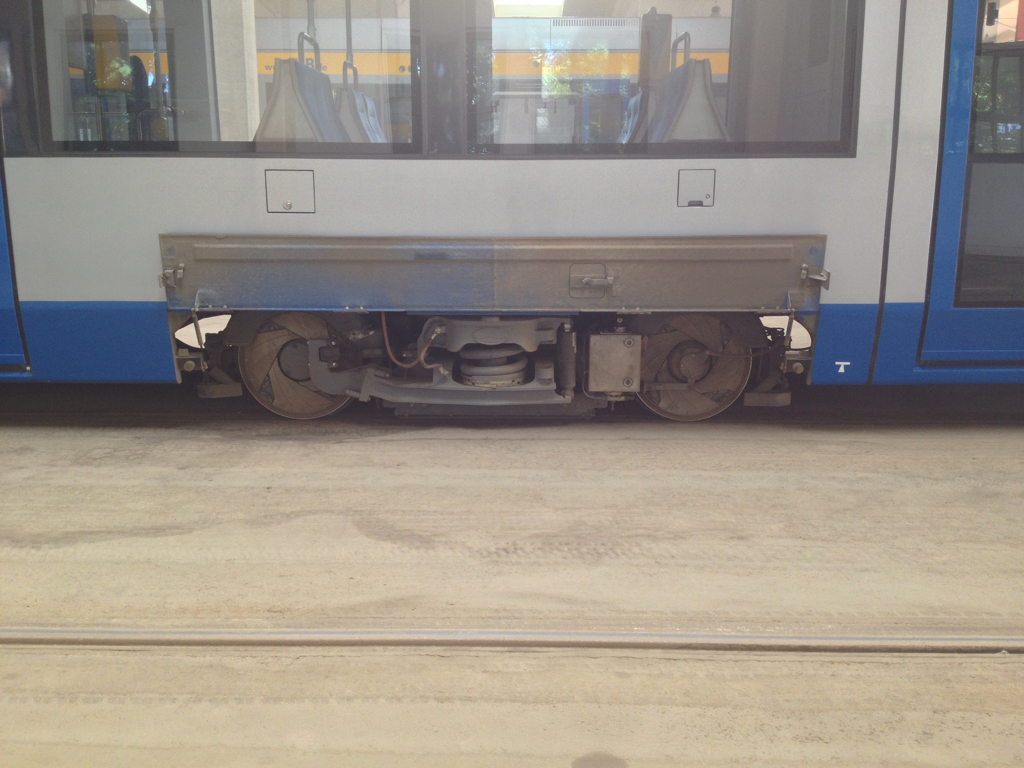
Once while I was at Angerbrücke, firemen were practising how to jack up a NGT12 in order to recover accident victims from underneath the car, on which occasion I was able to glimpse one of the motor bogies with the skirt flap folded up. Note the wheelsets again having inside bearings in order to save space and provide sufficient rotational motion for the bogies inside the underframe skirts. The wheelsets themselves are slowly being refitted with a newer type of annular noise absorber, replacing the layered sheet package type originally provided.

Effect view of Bogie #1.
Technically, the NGT12 is configured with five articulated body segments, of which #2 and #4 are designed as "floating" segments carried by the adjacent segments #1, #3 and #5. The latter three are also configured with two bogies each, with segments #1 and #5 comprising the motor bogies with conventional wheelsets, and #3 the trailer bogies with independent wheels. Cab and passenger space have separate air conditioning circuits. Passenger capacity on these cars is for 104 seated and 160 standing at 4 persons per square metre. The A/C and Drive Control Unit pods are set atop the roof.
Propulsion is provided by two Drive Control Units, supplying each pair of motor bogies, and two 85 kW asynchronous AC motors per bogie working through two-stage reduction gears. The holding brake works with electrohydraulic actuation and is provided in each motor bogie, with one pair of magnetic track brakes being provided in all bogies.
The main characteristics:
Overall length – 45.09 m
Overall width – 2.30 m
Overall height – 3.56 m
Configuration – Bo'Bo'2'2'Bo'Bo'
Wheel diameter – 600 mm
Wheelbase (all bogies) – 1.80 m
Minimum curve radius – 18 m
Empty service weight – 59.2 tonnes
Maximum service weight – 78.6 tonnes
Power output – 680 kW/912 hp
Design maximum speed – 70 kph (operational limit for all our types is 50 kph)
My personal impression of the NGT12 is that in spite of its considerable size and weight, these cars are very easy and carefree to handle, reducing fatigue and stress for the driver. They are also surprisingly agile considering their size and weight, and quite safe even in poor adhesion conditions. Their performance in an emergency stop is particularly impressive, with my estimate from our instruction being that they can stop roughly within their own length even from 50 kph. This tremendous braking force which is applied in emergency stops is why – on all our tram types – we must inquire as to possible injuries among passengers if we needed to pull an emergency stop in revenue traffic. They are, however, a bit top-heavy due to the considerable weight of the A/C pods and their cooling liquid in particular, and may thus commence oscillations more quickly on less well aligned track.
All in all, I personally tend to view them as the "Stretch Limos" in our inventory, as they're undoubtedly comfortable even during longer shifts. I haven't had any major malfunctions with them myself and I keep hearing they're highly reliable in general, with Bombardier also still going great lengths to providing optimal technical support even years after procurement.
Thank you for reading!
-
 5
5




0 Comments
Recommended Comments
There are no comments to display.
Create an account or sign in to comment
You need to be a member in order to leave a comment
Create an account
Sign up for a new account in our community. It's easy!
Register a new accountSign in
Already have an account? Sign in here.
Sign In Now